Velociraptor's Cousin Flaunted Fabulous Feathers, Tiny Arms

A flamboyant cousin of the fearsome Velociraptor, covered in layers of showy feathers from head to tail, once stalked meaty prey in the forests of what is now northeastern China.
The exquisitely preserved 125-million-year-old fossil shows that the roughly 5-foot-long (1.5 meters) dinosaur had clawed toes and fingers, sharp teeth, short arms and stunning plumage (unlike the scaly Velociraptors of "Jurassic World"), the researchers said. But it's unlikely the 45-pound (20 kilograms) dinosaur could fly, at least not by using the same muscle-driven flight as modern birds, they said.
A farmer found the fossil in Liaoning Province in northeastern China, an area famous for its feathered dinosaur fossils. Researchers reported on the first known dinosaur fossil with preserved feathers (Sinosauropteryx) from the province in 1996, and "now we have thousands of different dinosaur fossils covered in feathers," said co-researcher Steve Brusatte, a paleontologist at the University of Edinburgh. [See Detailed Photos of Velociraptor's Feathered Cousin]
But the newfound fossil has another distinction: It's the largest on record with well-preserved birdlike wings, Brusatte said.
The researchers named the new genus and species Zhenyuanlong suni in honor of Zhenyuan Sun, who secured the specimen for study, and "long," which means "dragon" in Chinese.
"It's one of the prettiest fossils I've ever worked on, and one of the prettiest fossils I've ever seen," Brusatte told Live Science. "It has all of the feathers all around it."

Zhenyuanlong's wings have three layers of complex feathers that look like quill pens, an unusual find given that other dinosaurs have simple feathers that looked like fuzzy hair and may have been used for insulation, he said.
Sign up for the Live Science daily newsletter now
Get the world’s most fascinating discoveries delivered straight to your inbox.
"Our discovery of Zhenyuanlong indicates that there is an even higher diversity of feathered dinosaurs than we thought," co-researcher Junchang Lü, a professor at the Institute of Geology, Chinese Academy of Geological Sciences, said in a statement. "It's amazing that new feathered dinosaurs are still being found."
Even though dense feathers covered the dinosaur's wings and tail, the meat-eating theropod dinosaur likely couldn't fly. At about 16 inches (40 centimeters) long, its arms were too short.
"I would expect that muscle power, forelimb bone strength, and stability (the short arms would tend to make it unstable in pitch) might all be issues that could stop Zhenyuanlong from being able to fly," said Michael Habib, an assistant professor of cell and neurobiology at the University of Southern California and a research associate at the Dinosaur Institute at the Natural History Museum of Los Angeles County, who was not involved with the study.
But short, feathered arms were likely still useful, even if they weren't used for flying.
"A broad wing like that on the new specimen could be important in display, covering eggs when tending nests, or other non-flight functions," Habib told Live Science in an email.
Zhenyuanlong's cousin Velociraptor, which lived about 50 million years later during the Late Cretaceous, had longer arms and also sported feathers. But it likely couldn't fly, either, Brusatte said. It's possible that feathers weren't originally developed for flight, and only later became instrumental for lift, he said.
The new study was published online today (July 16) in the journal Scientific Reports.
Originally published on Live Science.

Laura is the archaeology and Life's Little Mysteries editor at Live Science. She also reports on general science, including paleontology. Her work has appeared in The New York Times, Scholastic, Popular Science and Spectrum, a site on autism research. She has won multiple awards from the Society of Professional Journalists and the Washington Newspaper Publishers Association for her reporting at a weekly newspaper near Seattle. Laura holds a bachelor's degree in English literature and psychology from Washington University in St. Louis and a master's degree in science writing from NYU.
